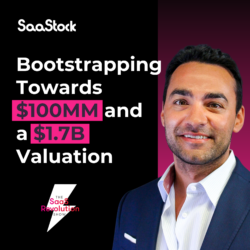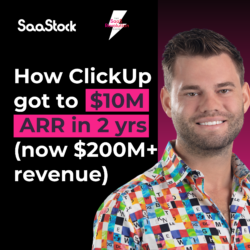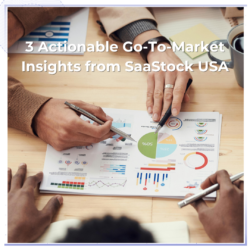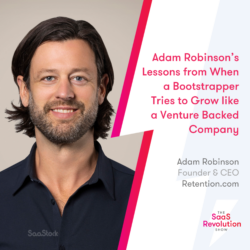This episode of The SaaS Revolution is a special recording from SaaStock Europe 2024.
In this 30-minute interview, Ryan Floyd (Founding MD at Storm Ventures) speaks to Joaquim Lecha (Former Typeform CEO) about the pivotal stages and key learnings from Typeform’s journey to $80M ARR and 150,000 customers.
They cover:
- The early stages of scale: From 38k to 150k customers.
- How to focus when your customer is “everyone”.
- Typeform’s approach to product development.
- Prioritisation and working in six week cycles.
- Typeform’s GTM motion, including paid vs organic strategies.
Watch (or listen) below, or read on for key takeaways.
From 38k to 150k: How to deliver a product when your customer is “everyone”
“Be happy. The total addressable market cannot be bigger. And so that’s a great place to start.”
When Joaquim joined Typeform in 2018, they had around 38,000 customers. By the time he left in 2024, that number had grown to 150,000.
This growth didn’t come from chasing every opportunity in a massive total addressable market (TAM). It came from narrowing it down.
Rather than diluting their efforts, Joaquim and team chose to concentrate on professionals as a starting point—turning broad potential into a focused audience they could add value for.
The three point framework for identifying customer segments
“You could have a marketer at a 150-person SaaS company using Typeform for lead gen—or for running an offsite. Same ICP, totally different use case.”
Once gaining traction amongst professionals, Typeform broadened their reach by targeting new customer segments. To do this intentionally, they developed a three point framework for defining those segments:
- Buyer Persona: Role e.g. marketer, salesperson, ops.
- ICP: Company size, region, industry etc.
- Use Case: What they want to achieve.
This approach allowed them to add nuance without losing focus.
Turning customer feedback into a muscle
At Typeform, customer feedback wasn’t a checkbox, it was a muscle the team deliberately built and exercised.
“Start establishing a muscle… customer research, customer focus groups… start doing that together with product development.”
In his first few months as CEO, Joaquim personally conducted 40-50 customer interviews. From there, they build a culture of customer insights and quick feedback loops, including:
- Regular focus groups.
- Alpha and beta testing groups.
- Survey data from their forms platform.
- Using usage data to spot gaps and opportunities.
Prioritisation: Good vs. critical
“There are plenty of good things we could do. But what are the three things we all together should do that are critical?”
With 150,000+ users, the number of things Typeform could build was huge. In order to prioritise, Joaquim differentiated between what was good and what was critical.
Under this mindset, features were evaluated against a number of criteria: simplicity, scalability, and speed of feedback.
“If we do something that only one customer uses, it feels like a lot of effort. But if 10–15% use it? That’s a good return.”
This criteria was measured through opportunity assessments that reviewed:
- Who is the customer?
- What is the problem?
- Why is it worth solving?
- Why is this the right solution?
The team sourced input from customer support, product feedback, sales win/loss analysis, and user behaviour data—then weighed it all through the lens of what would have the most impact for both business and customer.
Betting on the right things: Criteria for go-to-market
“If you attempt 25 things, you’ll execute poorly. But if you focus your team on three or four things, execution won’t be the problem.”
Joaquim’s emphasis on focus extended from product through to go-to-market strategy—run lean experiments and prioritise for scalability.
For example:
- Paid marketing gave quicker feedback than organic, which was content-heavy and slower.
- High vs low ACV products required different approaches. For example, the way they used events varied between the core product and Typeform for Growth (with a ~$3.8k ACV).
Get more from The SaaS Revolution Show
Across the entire business, Joaquim was clear that customer obsession is the key to prioritising the right features, building the right products, and scaling without chaos.
It’s a mindset echoed by other leaders on the podcast and at our events, including Superhuman Founder & CEO Rahul Vohra who took 700+ customer interviews, and WordPress Co-founder Matt Mullenweg who champions staying close to users and turning customer interaction into a competitive edge.





